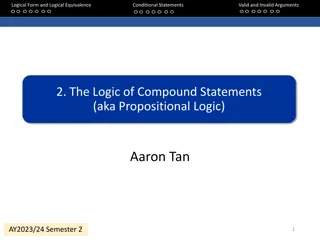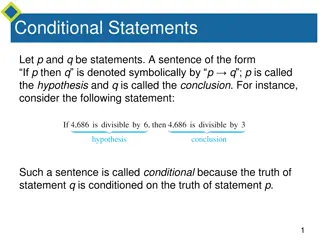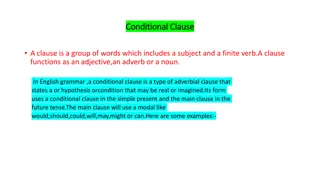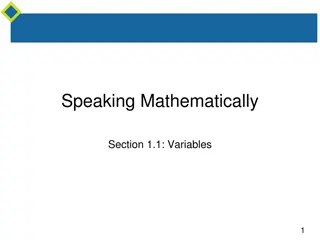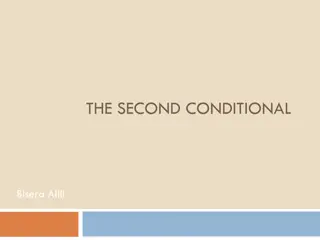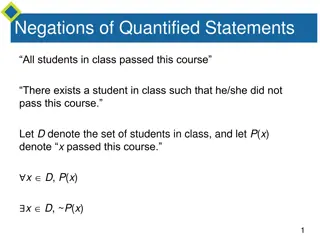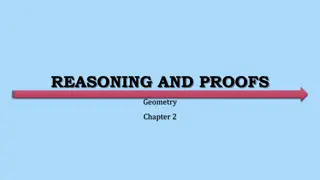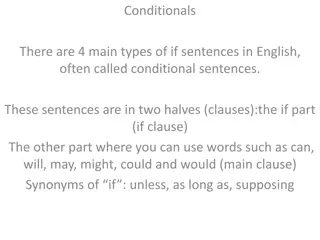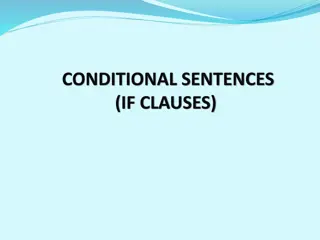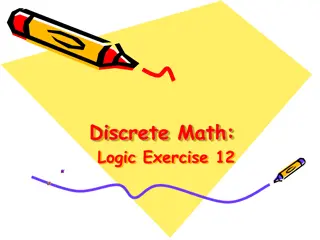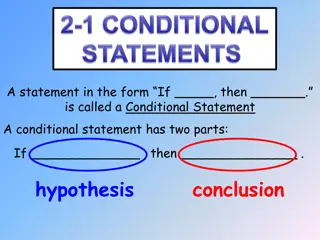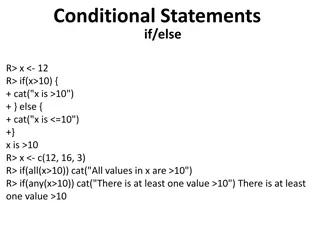Understanding Conditional Statements in Mathematics
A deep dive into conditional statements in mathematics, covering the concept of hypotheses and conclusions, the converse of conditionals, counterexamples, biconditionals, and inverses. Examples and visuals help clarify these important logical concepts.
Download Presentation

Please find below an Image/Link to download the presentation.
The content on the website is provided AS IS for your information and personal use only. It may not be sold, licensed, or shared on other websites without obtaining consent from the author. Download presentation by click this link. If you encounter any issues during the download, it is possible that the publisher has removed the file from their server.
E N D
Presentation Transcript
WHAT IS A CONDITIONAL? - A statement that contains if, then . A statement that contains if, then . - Ex: Ex: If If you study hard, you study hard, then then you will do well. you will do well. - Ex: Ex: If If a triangle contains one right angle, a triangle contains one right angle, then then it is a right triangle. it is a right triangle. All of the words AFTER if are called the hypothesis. All of the words AFTER if are called the hypothesis. All of the words All of the words AfTER AfTER then are called the then are called the conckusion conckusion. . In the above examples, identify the hypothesis and In the above examples, identify the hypothesis and concusion concusion. .
CONVERSE OF A CONDITIONAL Converse: switch the hypothesis and conclusion. Converse: switch the hypothesis and conclusion. Ex: Ex: Conditional Conditional - - If an angle is obtuse, then it measures more than 90 degrees. If an angle is obtuse, then it measures more than 90 degrees. Converse Converse If an angle measures more than 90 degrees, then it is obtuse. If an angle measures more than 90 degrees, then it is obtuse. ***Sometimes, a conditional statement may be true, but the converse turns out ***Sometimes, a conditional statement may be true, but the converse turns out false. Can you think of an example when this happens? false. Can you think of an example when this happens?
COUNTEREXAMPLES If something is false, a counterexample is used to prove that it is false. If something is false, a counterexample is used to prove that it is false. Ex: Ex: Conditional Conditional - - If you live in Hazleton, then you live in Pennsylvania. (TRUE) If you live in Hazleton, then you live in Pennsylvania. (TRUE) Converse Converse If you live in Pennsylvania, then you live in Hazleton. (FALSE) If you live in Pennsylvania, then you live in Hazleton. (FALSE) Counterexample Counterexample You can live in Pennsylvania, but in Freeland instead. You can live in Pennsylvania, but in Freeland instead. If x squared equals 4, then x equals 2. (FALSE) Provide a counterexample. If x squared equals 4, then x equals 2. (FALSE) Provide a counterexample.
BICONDITIONAL When a conditional and it s converse are BOTH TRUE, they can be combined together When a conditional and it s converse are BOTH TRUE, they can be combined together to form a to form a biconditional biconditional using the words using the words if and only if if and only if . . Ex: Ex: Conditional Conditional If a triangle has no congruent sides, then it is scalene. (TRUE) If a triangle has no congruent sides, then it is scalene. (TRUE) Converse Converse If a triangle is scalene, then it has no congruent sides. (TRUE) If a triangle is scalene, then it has no congruent sides. (TRUE) Because they are both true, we write a Because they are both true, we write a biconditional biconditional from the converse. from the converse. Biconditional Biconditional A triangle is scalene A triangle is scalene if and only if if and only if it has no congruent sides. it has no congruent sides. Create your own example! Create your own example!
INVERSE - Negate Negate both the hypothesis and conclusion of the original conditional statement both the hypothesis and conclusion of the original conditional statement - Ex: Ex: - Conditional Conditional If 2x + 5 = 11, then x = 3. If 2x + 5 = 11, then x = 3. - Inverse Inverse If 2x + 5 does not = 11, then x does not = 3. If 2x + 5 does not = 11, then x does not = 3. - YOUR TURN YOUR TURN
CONTRAPOSITIVE Negate Negate both the hypothesis and conclusion of the original conditional statement, and both the hypothesis and conclusion of the original conditional statement, and switch switch them. them. Ex Ex- - Conditional: If you lift weights, then you have muscles. Conditional: If you lift weights, then you have muscles. Contrapositive: If you do not have muscles, then you do not lift weights. Contrapositive: If you do not have muscles, then you do not lift weights. Your turn Your turn
DRAWING CONCLUSIONS If you are given a conditional statement and additional information, you can If you are given a conditional statement and additional information, you can draw conclusions conclusions (use common sense don t make this difficult!!!) (use common sense don t make this difficult!!!) draw Ex: Ex: Conditional Conditional If a triangle contains one obtuse angle, then it is an obtuse triangle. If a triangle contains one obtuse angle, then it is an obtuse triangle. Given Given - - ABC has obtuse angle B. ABC has obtuse angle B. Conclusion Conclusion - - Ex: Ex: Conditional Conditional If a ray bisects an angle, then it divides the angle into two smaller congruent If a ray bisects an angle, then it divides the angle into two smaller congruent angles. angles. Given Given - - Ray BD bisects angle ABC. Ray BD bisects angle ABC. Conclusion Conclusion - -
APPLY WHAT YOU LEARNED! 1. 1. Write a conditional and it s converse that are both true. Write a conditional and it s converse that are both true. 2. 2. Write a Write a biconditional biconditional. . 3. 3. Write the inverse. Write the inverse. 4. 4. Write the contrapositive. Write the contrapositive. 5. 5. Write a new conditional that has a false converse. Write a new conditional that has a false converse. 6. 6. Provide a counterexample . Provide a counterexample .


